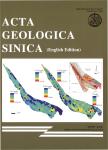Dawazisaurus Brevis, A New Eosauropterygian From the Middle Triassic of Yunnan, China
Dawazisaurus Brevis, A New Eosauropterygian From the Middle Triassic of Yunnan, China作者机构:National Museum of Natural Science 1 Kuan Chien Road Taichung Taiwan 40453 China Department of Earth Sciences National Cheng Kung University 1 University Road Tainan Taiwan 701 China Canadian Museum of Nature PO Box 3443 STN 'D’ Ottawa Ontario KIP 6P4 Canada Tokyo Gakugei University 4-1-1 Nukui-Kita-Maehi Koganei City Tokyo 184-8501 Japan
出 版 物:《Acta Geologica Sinica(English Edition)》 (地质学报(英文版))
年 卷 期:2016年第90卷第2期
页 面:401-424页
核心收录:
学科分类:070903[理学-古生物学与地层学(含:古人类学)] 0709[理学-地质学] 0819[工学-矿业工程] 07[理学] 0818[工学-地质资源与地质工程] 0708[理学-地球物理学] 0816[工学-测绘科学与技术]
基 金:supported by research grants from the NMNS and the National Science Council Taiwan(NSC-95-2116-M-178-001)(to Y.-n.C) from the CMN(RCP09 to X.-c.W) from Tokyo Gakugei University(to T.S)
主 题:Sauropterygia Dawazisaurus brevis Guanling Formation Early Triassic Yunnan China
摘 要:Dawazisaurus brevis(gen. et sp. nov.) is a newly discovered Triassic marine reptile, represented by a complete skeleton from Member II of the Guanling Formation of Luoping, Yunnan Province, China. This paper aims to(1) present a thorough description of the species,(2) make a detailed comparison to demonstrate if the species can be referred to any known sauropterygian taxa, and(3) conduct phylogenetic analyses to establish the internal relationships of the species with other sauropterygians. In addition, the discovery of Dawazisaurus provides a chance not only to test the phylogenetic patterns of the Sauropterygia obtained by previous studies but also to evaluate the previous hypotheses on the origin of the sauropterygian groups at different levels. D. brevis is an eosauropterygian, characterized by a unique combination of derived features such as a pair of large nasals joining in the formation of the internarial septum, a short trunk with 16 dorsal vertebrae; the zygapophyses of the trunk vertebrae very small or weakly developed; the posterior margin of the skull roof deeply V-shaped, and an ossified distal carpal 5. Phylogenetic analysis indicates that D. brevis appears to be more closely related to the Nothosauroidea than the Pistosauroidea within the Eosauropterygia.



